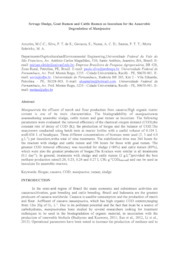Sewage sludge, goat rumen and cattle rumen as inoculum for the anaerobic degradation of manipueira.
Sewage sludge, goat rumen and cattle rumen as inoculum for the anaerobic degradation of manipueira.
Autoria: AMORIM, M. C. C.; SILVA, P. T. de S. e; GAVAZZA, S.; NUNES, A. C. D.; SANTOS, P. T. T.; MOTTA SOBRINHO, M. A.
Resumo: Manipueirais the effluent of starch and flour production from cassava. High organic matter content is one of its main characteristics. The biodegradability of manipueira was assessed using anaerobic sludge, cattle rumen and goat rumen as inoculum. The following parameters were evaluated: the removal efficiency of the chemical oxygen demand (COD); the constant rate of decay of COD (K); the production of biogas and the balance of COD.The essays were conducted using batch tests at reactor bottles with a useful volume of 0.104 L andO.026 L of headspace. Three different concentrations of biomass were used (2, 3 and 4.0 g.L-I) per inoculum, with a total of nine treatments. The stabilization time was 264 hours for the reactors with sludge and cattle rumen and 196 hours for those with goat rumen. The greatest COD removal efficiency was recorded for sludge (>80%) and cattle rumen (89%), which were also the greatest producers of biogas.The values were similar in all treatments (0.1 day'). In general, treatments with sludge and cattle rumen (2 g.L-I)provided the best methane production rates(0.20, 0.23, 0.24 and 0.27 L CH4 g-ICODrcmoved)and can be used as inoculum for anaerobic reactors.
Ano de publicação: 2014
Tipo de publicação: Artigo em anais e proceedings
Unidade: Embrapa Semiárido
Palavras-chave: Biogás, Cassava, Degradação de manipueira, Mandioca, Manipueira, Rúmen
Observações
1 - Por padrão são exibidas publicações dos últimos 20 anos. Para encontrar publicações mais antigas, configure o filtro ano de publicação, colocando o ano a partir do qual você deseja encontrar publicações. O filtro está na coluna da esquerda na busca acima.
2 - Para ler algumas publicações da Embrapa (apenas as que estão em formato ePub), é necessário ter, no celular ou computador, um desses softwares gratuitos. Sistemas Android: Google Play Livros; IOS: iBooks; Windows e Linux: software Calibre.
Acesse outras publicações
Acesse a Base de Dados da Pesquisa Agropecuária (BDPA) para consultar o acervo completo das bibliotecas da Embrapa.

